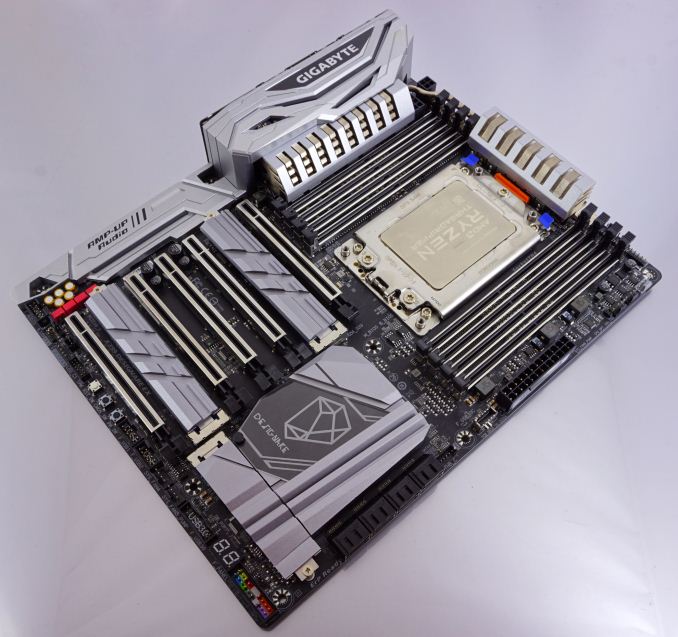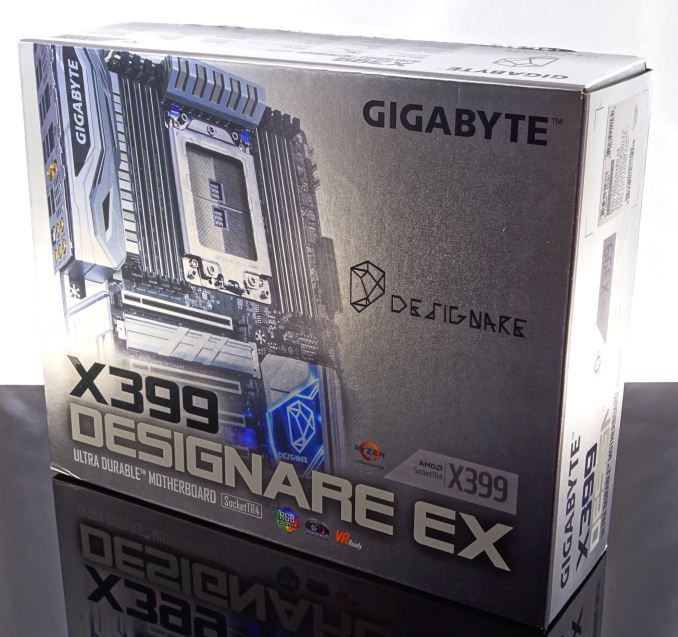The GIGABYTE X399 DESIGNARE EX Motherboard Review
by E. Fylladitakis on June 22, 2018 11:30 AM EST- Posted in
- Motherboards
- Gigabyte
- ASRock
- Asus
- Ryzen
- ThreadRipper
- X399
- 1950X

Even now, almost a year after the launch of the Ryzen Threadripper processors by AMD, there are only a few X399 motherboards available in the market. Threadripper aims for the top end of the enthusiast and workstation market, and comes with a price tag, therefore it is only natural that motherboard manufacturers would not expend much of their resources on such a limited market. As a result, GIGABYTE only offers two motherboard options to date: the gaming-focused AORUS X399 Gaming 7 and the feature-packed X399 Designare EX, but we do know that an X399 Aorus Extreme is also set to be released in the near future. In this review, we are having a look at the X399 Designare EX, the current GIGABYTE Halo implementation of AMD's X399 chipset.
The Designare EX is the most expensive and feature-packed motherboard GIGABYTE has to offer, yet its features seem to have been selected with productivity in mind. For example, gaming-specific features such as an Intel E2500 Killer LAN gaming chipset are implemented on the cheaper AORUS Gaming 7 motherboard, yet not on the Designare EX, instead going for dual Intel networking ports and Wi-Fi. As its name hints, GIGABYTE is probably targeting this motherboard more towards professionals and designers.
AnandTech's AMD Ryzen Threadripper and X399 Motherboard Coverage
- The AMD Ryzen Threadripper 1950X and 1920X Review: CPUs on Steroids
- An AMD Threadripper X399 Motherboard Overview
- Analyzing Threadripper Thermals: Big Base Cooling Wins
- AMD Reveals Threadripper 2 : Up to 32 Cores, 250W, X399 Refresh
- GIGABYTE’s X399 Aorus Extreme: The Threadripper 2 Halo Motherboard
- New EKWB Threadripper X399 Monoblocks for GIGABYTE and MSI
GIGABYTE X399 Designare EX Overview
The GIGABYTE X399 Designare EX is a motherboard designed to be both feature-packed and reliable. Its list of features is very long and, despite the massive size of the processor's socket and the eight DDR4 RAM slots, the dimensions of the GIGABYTE X399 Designare EX are exactly those of a typical ATX motherboard, allowing it to be installed inside any typical ATX-compliant case.
A quick glance at the motherboard's specifications reveals that up to eight SATA drives and three M.2 drives can be connected on the GIGABYTE X399 Designare EX. The motherboard does not have a U.2 drive connector, making GIGABYTE the only manufacturer who did not add one on their top-tier AMD X399 motherboard. However, GIGABYTE supplies a U.2 to M.2 adapter, allowing the connection of a U.2 drive onto any of the motherboard's three M.2 slots. The motherboard also has a massive number of USB 3.1 Gen 1 ports and there are also two USB 3.1 Gen 2 ports, one Type-A and one Type-C.
In terms of connectivity, the motherboard has dual Intel I211-AT Gigabit LAN controllers, plus an Intel 802.11ac/Bluetooth 4.2 wireless adapter. The I211-AT are renowned for their efficiency and stability (and it is not bad for gaming either). The wireless card supports speeds up to 867 Mbps.
GIGABYTE heavily advertises the audio capabilities of the X399 Designare EX, focusing on the Creative Sound BlasterX 720° support. Note that Sound BlasterX 720° is not a chipset but a software package that is designed to work with any compatible chipset/motherboard. Realtek supplies the well-known ALC 1220 audio chipset that also has an integrated smart headphones amplifier.
One of the truly unique features of the GIGABYTE X399 Designare EX is the presence of a fifth full-length PCIe slot. Like every other AMD X399 motherboard, the GIGABYTE X399 Designare EX has four PCI Express slots that are directly connected to CPU lanes (×16 / ×8 /×16 / ×8), but right in the middle of these four slots, the Designare has an added a fifth full-length PCI Express slot with four lanes connecting to the chipset.
The second important feature of the GIGABYTE X399 Designare EX is the implementation of an International Rectifier IR35201 digital controller. What is unique about this particular controller is that it implements an algorithm that balances the load (and the heat output) across all of the power phases. This means that instead of having a couple of stages heavily loaded all of the time while the rest are idling, all eight stages are continuously sharing about the same load, greatly increasing the longevity of the circuitry. This means that the motherboard should hold up well for the upcoming Threadripper 2 launch.
Overall, the X399 Designare EX is a motherboard that seems to be leaning more towards professionals. There are gaming-related features, such as RGB lighting and support for external RGB strips, but these are more of an exception rather than the rule. The company refrained from adding gaming-focused chipsets or complex/untested circuitry, sticking to heavily tested and proven choices. As we will see in the following pages, GIGABYTE also focused on the cooling capabilities and the physical strength of the motherboard a lot as well, hinting that the X399 Designare EX has been developed in order to please users who seek stability and reliability above all else.












20 Comments
View All Comments
Komachi_Ensaka - Friday, June 22, 2018 - link
Great Article.BTW this Board has a THB_C Header.
Any update THB_C Header/GC-ALPINERIDGE(ThunderBolt 3 exCard) about this MB from GIGABYTE?
Cooe - Saturday, June 23, 2018 - link
Intel still hasn't actually opened up the licensing. They said they were going to like 2 years ago at this point, but have managed to drag their feet through avoiding actually pulling the trigger to the present day.Basically, everyone with TB3 compatible hardware, but no valid software & driver license is pretty much stuck holding their junk in their hands ever waiting on an non-motivated Intel. This is almost surely the reason why the only X399 board (or AMD board of any kind actually) to have said TB3 HW was this particular SKU (having ofc been added to it's design at a point when it seemed like they'd be able to activate/enable it not long after the board would launch), and this includes the so far shown X399 refresh boards.
eek2121 - Sunday, June 24, 2018 - link
Hrm, overclocking depends on the chip. My TR used to be Rock solid stable at 1.225V @ 4.0 and 1.35V at 4.1. However, I like to play with my chips, so on my MSI I have had it as high as 1.65V @ 4.4 GHz. At that speed it beat every Intel chip to date for every benchmark I ran, but also degraded my CPU in a few hours. However, it can still do 4.0 @ 1.288V, which keeps the chip well under 68C even under Prime95.tspacie - Friday, June 22, 2018 - link
Question about test setup (and DPC latency); do you install all the optional drivers that come with the Mobos or just whatever Windows Update finds?E.Fyll - Saturday, June 23, 2018 - link
All of the tests take place after installing all the drivers and related software that comes with the manufacturer's CD/flash media. We only skip the installation of any "optional" software that may be includes, such as toolbars and application demos. Note that installing most driver packages just installs the manufacturer's utility/tool/interface and not the driver, as the OS will generally not replace current drivers with older versions (not unless forced).cyberguyz - Friday, June 22, 2018 - link
Having owned a Gigabyte X399 Aorus Gaming 7 (It died for the same reasons that seem to have happened to quite a few others :( not gonna go into that here) I see very little difference between my Late X399 Aorus and this board:The boards are pretty much identical except for second Intel I211 ethernet replacing the Killer ethernet. B oth boards sport 2x GB ethernet and onboard 1200AC wireless. They both have 5x metal-clad x16 slots with the middle one disguising an x4 slot. They both have 3x pcie gen3 M.2 slots in the exact same places. They both have 8x sata3 ports and the same number of external & internal Gen 1 USB3 3.1 ports the same 2 USB gen2 ports - one 'A' and one 'C'. The number of power phases and audio controller + capacitors and software.
In fact the only distinguishing features I can see are the metal backplate while the Aorus is littered everywhere with with RGB leds, the differing second ethernet port and possibly the M2->U2 adapter.
Not really seeing the excitement with this one other than a little bit of steel rather than bling (I really don't see the value or detriment of the Killer vs Intel ethernet).
Arbie - Friday, June 22, 2018 - link
The undervolted result is really interesting - cutting power in half! Did you by any chance capture the difference in idle watts? That's where my system is 99% of the time, and as I recall TR's idle dissipation was about twice that of a Ryzen 1800. Of course I could undervolt the latter too... something to consider.zirk65 - Saturday, June 23, 2018 - link
I had the same thought about idle watts, whether the memory controller is still the likely consumer.E.Fyll - Saturday, June 23, 2018 - link
I did not test that extensively but the difference in idle is about 7-8 Watts, depending on the motherboard. It is not as impressive as the difference under load but not negligible either. Tweaking could probably improve that a little bit further but I highly doubt that the idle energy consumption can ever reach that of single-die processors.eek2121 - Sunday, June 24, 2018 - link
Set you minimum processor power management to. 4.0 GHz. Set P0 pstate to a lower level or bump up LLC...